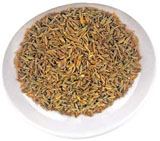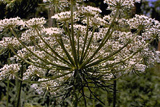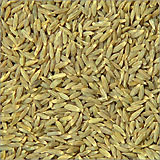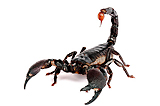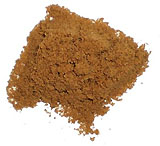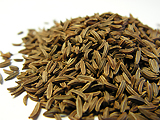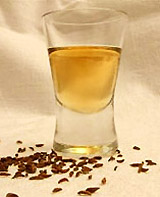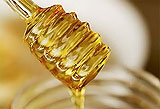Medicinal Plants
Jeeraka or cumin and caraway (Cuminum cyminum and Carum carvi)
Cuminum cyminum
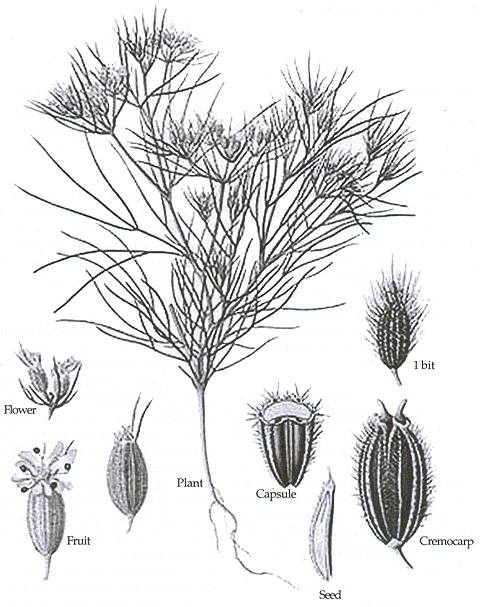
Introduction
Cumin has been in use since ancient times. Seeds excavated at the Syrian site Tell ed-Der have been dated to the second millennium BC. They have also been reported from several New Kingdom levels of ancient Egyptian archaeological sites.
Originally cultivated in Iran and the Mediterranean region, cumin is mentioned in the Bible in both the Old Testament (Isaiah 28:27) and the New Testament (Matthew 23:23). It was also known in ancient Greece and Rome. The Greeks kept cumin at the dining table in its own container (much as pepper is frequently kept today), and this practice continues in Morocco.Like many others from the family, it is probably a native of the Mediterranean region but is now cultivated in many parts of the world, especially in southern Europe and India.
A native also of Egypt and Syria, the plant is extensively cultivated as a cold season crop in the plains and as a summer crop in the hills of north India and the Himalayas; some amount is also imported from Iran and Eastern Europe.
Superstition during the Middle Ages cited that cumin kept chickens and lovers from wandering. It was also believed that a happy life awaited the bride and groom who carried a cumin seed throughout the wedding ceremony.
There are two ‘varieties’ of jeeraka which actually belong to two separate genera altogether: white or shweta jeeraka (Cuminum cyminum) and the black or krishna jeeraka (Carum carvi). The term jeeraka refers to the digestive efficiency of the grains, their chief value in medicine.
1. Cuminum cyminum (white jeeraka)
The English ‘cumin’ derives from the Old English ‘cymen‘ (or Old French ‘cumin’), from Latin ‘cuminum’ which is the romanisation of the Greek ‘‘κύμινον’ (kuminon), cognate with Hebrew kammon, Arabic kammun. Forms of this word are attested in several ancient Semitic languages, including kamûnu in Akkadian. The ultimate source is the Sumerian word gamun. The earliest attested form of the word κύμινον (kuminon) is the Mycenaean Greek ku-mi-no, written in Linear B syllabic script.
The fruits are used for many purposes — in the kitchen for seasoning in soups and curries, cakes, bread, cheese, pickles and are also often candied. Its oil is used in perfumery and in flavouring beverages.
Botany
Cumin ‘seeds’ belong to a single family of small scented herbs known as Umbelliferae. The cumin plant grows to 30-50 cm (0.98-1.6 ft) tall and is harvested by hand. It is a herbaceous annual plant, with a slender branched stem 20-30 cm tall. The leaves are alternate, simple or compound and have a sheathing leaf base below. The flowers are small, pink and characteristically borne in umbels or umbrella-like clusters, where a large number of flowers with stalks of equal length spring from a common point so that all of them bloom at the same level. The flowers have both male and female structures together and an inferior ovary that develops into a very characteristic fruit called a cremocarp. This is dry, capsular and invariably breaks at maturity into two one-seeded bits, with a ribbed wall that has a number of longitudinal oil canals. It is these latter that give the characteristic odour, flavour and the very value to the fruit itself. Though these grain-like fruits are called the seeds, the true seeds are within them and come out only during germination through disintegration of the fruit wall.Cumin seeds resemble caraway seeds, being oblong in shape, longitudinally ridged and yellow-brown in colour, like other members of the Umbelliferae family such as caraway, parsley and dill.
Names
In Sanskrit it is called jeñrakam,śukla ajaji, and jaraṇa. It is known as safed jeera, jira, shai jira in Hindi and Bengali; zero in Sindhi; zeera, zira in Iranian; safed jiraun, zera in Gujarati; jeeraka in Telugu, jeerige in Kannada; shiragam in Tamil; jeera in Konkani and Marathi; kamun, kammon in Arabic.Constituents
The fruit contains a fatty oil, resin, mucilage, protein compounds and an essential volatile oil which gives it its characteristic odour and taste. A valuable essential oil, thymine, rich in carvone obtained from the seeds contains 56 per cent, cuminol, a mixture of hydro-carbons, cymol, terpenes, etc. Thymol is found in ajwain also. The oil is colourless or pale yellow with a strong odour and flavour characteristic of the fruit. Cumin’s distinctive flavour and strong, warm aroma is due to its essential oil content. Its main constituent and important aroma compound is cuminal-dehyde (4-isopropylbenzaldehyde). Important aroma compounds of toasted cumin are the substituted pyrazines, 2-ethoxy-3-isopropyl-pyrazine, 2-methoxy-3-sec-butylpyrazine, and 2-methoxy-3-methylpyrazine.Their nutritional value is as follows: 18.7 protein, 15.0 fat, 36.6 carbohydrates, and 5.8 mineral salts. The caloric or energy value is 356. Although cumin seeds contain a relatively large proportion of iron, extremely large quantities of cumin would need to be consumed for it to serve as a significant dietary source.
Medicinal uses
The ‘seeds’ are most effective carminatives. They are aromatic, stomachic (i.e. good for the stomach), stimulative and astringent.They are also cooling.Āyurveda and Siddha regard jeeraka as having a bitter taste with a hot property, capable of removing vāta and kapha doṣas but causing pitta. It is dry, astringent, appetising, digestive, strengthening, light for digestion, good for the eyes and an aphrodisiac. It is used in the treatment of indigestion, dysentery, enlarged spleen, flatulence and vomiting.
Yunani regards it as hot, carminative, digestive and astringent. It is employed in kapha diseases, menstrual disturbances and hiccups.
Uses as household remedy
i. Hoarseness of voice10-30 grains of the seeds are taken for hoarseness of voice, dyspepsia and chronic diarrhoea.
ii. Pain from worms
External application as a poultice allays pain and irritation of worms in the abdomen.
iii. Scorpion stings
The seeds are powdered, mixed with honey, salt and ghee and applied on scorpion stings to relieve pain.
iv. Nausea during pregnancy
For pregnant women, seeds are ground and mixed with lime juice and given in cases of bilious nausea.
v. Increasing milk secretion
Intake of jeeraka soon after childbirth is said to increase milk secretion.
vi. Hiccups
For hiccups, some seeds are kept in the chilam and smoked.
vii. Colic in children
Cumin water is commonly used as a carminative and believed to be useful in colicky pains of children.
viii. Nose bleeds
A decoction of jeeraka with vinegar or by itself as a nasal drop will stop nose bleeding (Yunani).
ix. Running nose
Drinking a decoction of cumin and vinegar relieves body pain, cold and running nose as well as insanity.
x. Flatulence
A drink from cumin powder improves digestive ability and destroys flatulence. Using cumin seeds after slightly roasting them improves their medicinal value.
The classical importance of jeeraka in Āyurveda can be gauged by references from the works of a few selected authors, as below:
Shodala: In case of fever due to vāta and kapha, eat powdered cumin seeds together with honey or jaggery. Then make the patient drink buttermilk and sit in the sun till he sweats. The fever will then subside.
Vrinda Madhava: Prepare some ghee from a paste of cumin and coriander seeds. Consuming this daily as required will rectify plethora or amlapitta, poor digestion, loss of taste in food, vomiting as well as various kapha and pitta disorders.
2. Carum carvi, Linn.
(Krishnajiraka or kalajira (Hindi), caraway
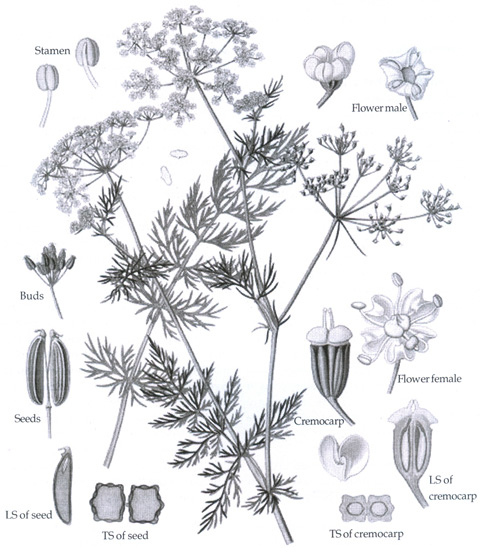
Carum carvi, also known as Meridian Fennel or Persian Cumin, is a biennial plant in the family Apiaceae, native to western Asia, Europe and northern Africa. The plant grows wild in the north Himalayan regions but is cultivated in the plains as a cold season crop and as a summer crop in the hills of Kashmir, Kumaon, Garhwal and Chamba at an attitude of 3,000-4,000 metres.
Commercial samples of kalajeera in India consist of the fruits of three separate species. They are C. carvi (a fruit larger and laterally compressed C. gracile (the fruits are smaller and dorsally subcompressed) and C. bulbocastanum (fruits are smaller and darker).
The fruits are used in the baking industry, perfumery, medicines and in some beverages. Cumin seeds resemble caraway seeds but are larger and paler in colour.
Caraway oil is used chiefly for flavouring wines, scenting soaps and in perfumes.
Names
Carum’s names in Sanskrit are: Kṛṣṇajīraka meaning the dark cumin, jaraṇa, karavi meaning a black crow (Interestingly the Greek term karon, similar to Arabic karwiya and the Sanskrit karavi — all mean raven — a black crow), kāśmīra jīraka.It is known as syahajeera, kalajeera in Hindi; shah jeera in Gujarati; shaha jire in Marathi; shajeera in Bengali; syahjeera, jire kirmani in Persian; kamum, kirmant in Arabic; seema sompu in kannada; shimal shombu in Tamil; shima jeerakam in Malayalam and sima julakara in Telugu.
Botany
The plant is similar in appearance to the carrot plant, with finely divided, feathery leaves with thread-like divisions, growing on 20-30 cm stems. The main flower stem is 40-60 cm tall, with small white or pink flowers in umbels. Caraway fruits (erroneously called ’seeds’) are crescent-shaped achenes, around 2mm long, with five pale ridges.The plant prefers warm, sunny locations and prospers well-drained soil.Constituents
A valuable essential oil rich in carvone is obtained from the seeds which are colourless or pale yellow and with the strong odour and flavour of the fruit. These also contain 8-20 percent of fixed oil, protein, calcium, oxalate, colouring matter and resin.Medicinal properties
Āyurveda regards it as appetising, stimulating, digestive, astringent, strengthening and good for the brain and eyes, improving lactation. It is beneficial for heart disease, swellings, tastelessness, vomiting, poor digestion and chronic fever.
Its taste is bitter, qualities are light and dry,its potency is hot and post-assimilation effect is bitter.
The fruits are carminative, stomachic and lactagogic.
Uses as a household remedy
i. VomitingTake cumin seeds, old jaggery and tamarind fruit pulp all in equal quantity and pound them well together. Prepare small balls of the mixture and slowly suck the juice. This wards off vomiting that may be due to liver complaints,stomach upsets or dizziness.
ii. Prickly heat
To get rid of the irritating and distressful prickly heat commonly prevalent in summer, powder cumin seeds to a fine degree, mix this powder thoroughly in coconut oil and apply over the affected parts, then take a bath after some time. Continue this practice for a few days, after which take a head bath once a week. During this time also consume cooling dishes such as koshimbir (a Maharashtrian salad), other salads, coconut water, fresh fruits, cucumber, etc to a greater extent than usual and decrease your consumption of sugar. This will cool your whole constitution and remove prickly heat.
iii. Jaundice
Cumin seeds are used to pacify aggravated pitta, which is also beneficial against jaundice. Take a fruit from the citrus family such as a lemon or orange. Cut it into two halves. Fill them well with cumin seed powder, stuffing it into the fruit pulp by pushing it through with a small stick. Keep the halves in warm ash for some time, then squeeze out the juice and drink it directly on an empty stomach. All diseases born out of excess of biliary aggravation will be removed by this treatment. If one keeps taking this daily for a fortnight, even jaundice will disappear.
iv. For pacifying pitta doṣa
A simple measure for pacifying pitta doṣa in general is to drink buttermilk with cumin powder and salt. Taking a cupful of this drink daily is undoubtedly healthy for those with pitta doṣa.
v. For pacifying pitta doṣa
Another simple but very useful recipe is to prepare a decoction with a teaspoonful of cumin seeds in a cup of water. Add to this a teaspoonful of the juice of fresh coriander leaves and a pinch of salt. This remedy taken twice a day after meals proves beneficial for dizziness, excessive salivation due to biliary complaints, stomach upsets, flatulence, dysentery and the like.
vi. For pacifying pitta doṣa
One more recipe for mitigating all kinds of aggravations of pitta is to consume half a teaspoonful of cumin powder with a teaspoonful of tamarind gruel and honey. This medication is also beneficial for jaundice.
vii. Increasing the appetite
Chewing a few grains of cumin before meals, particularly heavy meals, is always advisable. It increases the appetite. Chewing them after meals helps in digesting the food taken in. Eating them after chewing them well is doubly useful as it also prevents dental cavities and avoids constipation.
viii. During pregnancy
Cumin is especially beneficial for pregnant ladies. Taking a cumin decoction mixed with milk and honey daily will assure a good development of the child during pregnancy and an easy delivery later. In addition, this also promotes abundant milk secretion. The same decoction acts as a nourishing tonic to patients of anaemia, nervous debility and growing children,
ix. Scabies
A solution of caraway oil, alcohol and castor oil is recommended for scabies.
x. Mouth ulcers
Boil ground jeera in water and allow it to cool down. Add a pinch of cardamom to filtered jeera water. Gargling with this flavoured water helps to keep the mouth fresh, heals mouth ulcers and eliminates any foul smell.
xi. Bleeding gums
Roast jeera without oil till it is warm. Grind this to a fine powder along with rock salt. Massage gums with this powder. This helps to prevent bleeding from the gums and strengthens them.
xii. Diarrhoea
Consuming powdered jeera with honey reduces colic pain and reduces diarrhea caused due to indigestion.
xiii. Colds
A tea prepared by boiling cumin seeds and a small piece of fresh ginger help to give relief from common colds.
xiv. Irritable bowel syndrome
Patients suffering from irritable bowel syndrome can use pomegranate juice mixed with roasted and ground jeera powder. This helps to reduce the frequency of stools and soothes the colon.
Caution
Precaution has to be taken while roasting cumin seeds. Cumin seeds have to be roasted over a low heat till they become warm and should be taken off from stove when they are sufficiently warm to touch. This precaution helps to prevent the escape of volatile compounds of jeera.Bibliography
1. K.M. Nadkarni. Indian Materia Medica, Vol. I. Mumbai; Popular Prakashan Private Ltd., 1982.2. K.R. Kirtikar and B.D. Basu. Indian Medicinal Plants, Vol II. Dehradun; International Book Distribution, 1988.
3. Naveen Patnaik. The Garden of Life. New Delhi; Harper Collins Publishers, 1993.
4. N.K. Shanmugam. Mooligai Kalai Kalanjium. Chennai; Kalaiselvi Publications, 1997.
5. P.K. Warrier, V.P. Nambiar, C. Ramankutty. Indian Medicinal Plants. Chennai; Orient Longman Limited, 1996.
6. The Wealth of India. New Delhi; Publications and Information Directorate, CSIR, 1976, [Vol.X]: 171-7.
7. The Useful Plants of India. New Delhi; Publications and Informations Directorate, CSIR, 1986.
8. Bhandari, Chandraraj. Vanauṣadhī Candrodaya. Varanasi; Chaukhambha Sanskrit series, 1970.
Dr. K.H. Krishnamurthy wrote about medicinal plants as used in the Indian context with deep interest.
Share with us (Comments, contributions, opinions)
When reproducing this feature, please credit NAMAH, and give the byline. Please send us cuttings.
